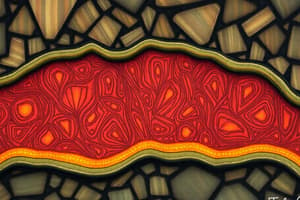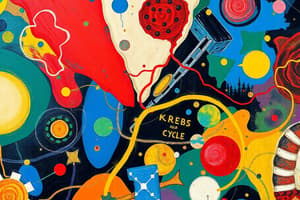Podcast
Questions and Answers
Where does the Krebs cycle take place?
Where does the Krebs cycle take place?
- Mitochondria of eukaryotes and the cytosol of prokaryotes (correct)
- Nucleus of eukaryotes and the cytoplasm of prokaryotes
- Ribosomes of eukaryotes and the cell wall of prokaryotes
- Endoplasmic reticulum of eukaryotes and the cytoplasm of prokaryotes
What is the initial product of the oxidation of pyruvate by pyruvate dehydrogenase complex?
What is the initial product of the oxidation of pyruvate by pyruvate dehydrogenase complex?
- NADH
- Glucose
- Acetyl-coa (correct)
- Carbon dioxide
Which compound combines with acetyl-coa to initiate the Krebs cycle?
Which compound combines with acetyl-coa to initiate the Krebs cycle?
- Oxaloacetate (correct)
- Isocitrate
- Citrate
- Succinyl-CoA
What is the final product of the Krebs cycle?
What is the final product of the Krebs cycle?
How many times does the Krebs cycle run for each glucose molecule?
How many times does the Krebs cycle run for each glucose molecule?
What is the main purpose of NADH and FADH2 produced in the Krebs cycle?
What is the main purpose of NADH and FADH2 produced in the Krebs cycle?
What is the main purpose of the Krebs cycle?
What is the main purpose of the Krebs cycle?
What is the role of NADH produced in the Krebs cycle?
What is the role of NADH produced in the Krebs cycle?
What is the initial product of the oxidation of pyruvate by pyruvate dehydrogenase complex?
What is the initial product of the oxidation of pyruvate by pyruvate dehydrogenase complex?
What is the end product of the Krebs cycle?
What is the end product of the Krebs cycle?
Which compound combines with oxaloacetate to initiate the Krebs cycle?
Which compound combines with oxaloacetate to initiate the Krebs cycle?
What is the main function of FADH2 produced in the Krebs cycle?
What is the main function of FADH2 produced in the Krebs cycle?
Where does the Krebs cycle take place in eukaryotic cells?
Where does the Krebs cycle take place in eukaryotic cells?
What is the carbon compound formed when acetyl-coa combines with oxaloacetate to initiate the Krebs cycle?
What is the carbon compound formed when acetyl-coa combines with oxaloacetate to initiate the Krebs cycle?
What is the compound that is converted into malate and then oxaloacetate, reducing NAD+ to NADH in the Krebs cycle?
What is the compound that is converted into malate and then oxaloacetate, reducing NAD+ to NADH in the Krebs cycle?
What is the total number of NADH produced from one molecule of glucose in the Krebs cycle?
What is the total number of NADH produced from one molecule of glucose in the Krebs cycle?
Which compound is formed by the conversion of alpha-ketoglutarate, producing NADH and carbon dioxide in the Krebs cycle?
Which compound is formed by the conversion of alpha-ketoglutarate, producing NADH and carbon dioxide in the Krebs cycle?
What is the end product of the conversion of succinyl-CoA, which generates GTP in the Krebs cycle?
What is the end product of the conversion of succinyl-CoA, which generates GTP in the Krebs cycle?
What is the compound formed when pyruvate is oxidized into acetyl-coa by pyruvate dehydrogenase complex, producing a molecule of NADH and carbon dioxide in the Krebs cycle?
What is the compound formed when pyruvate is oxidized into acetyl-coa by pyruvate dehydrogenase complex, producing a molecule of NADH and carbon dioxide in the Krebs cycle?
Which compound combines with oxaloacetate to form citrate, initiating the Krebs cycle?
Which compound combines with oxaloacetate to form citrate, initiating the Krebs cycle?
Flashcards are hidden until you start studying
Study Notes
- The Krebs cycle, also known as the tricarboxylic acid cycle, is a biochemical pathway that generates energy through the oxidation of acetyl-coa and produces NADH and amino acids.
- Takes place in the mitochondria of eukaryotes and the cytosol of prokaryotes.
- Pyruvate derived from glucose through glycolysis, split into two pyruvate molecules.
- Pyruvate is oxidized into acetyl-coa by pyruvate dehydrogenase complex, producing a molecule of NADH and carbon dioxide.
- Acetyl-coa combines with oxaloacetate to form citrate, a six carbon compound.
- Citrate is isomerized into isocitrate, then oxidized into alpha-ketoglutarate, producing NADH and carbon dioxide.
- Alpha-ketoglutarate is converted into succinyl-CoA, producing NADH and carbon dioxide.
- Succinyl-CoA is converted into fumarate, generating GTP.
- Fumarate is converted into malate, then oxaloacetate, reducing NAD+ to NADH.
- One molecule of glucose results in the production of six NADH, two FADH2, one GTP, and four carbon dioxide.
- All NADH and FADH2 are used in the electron transport chain to generate ATP.
- Glucose split into two pyruvate, so the cycle runs twice for each glucose molecule.
Studying That Suits You
Use AI to generate personalized quizzes and flashcards to suit your learning preferences.




